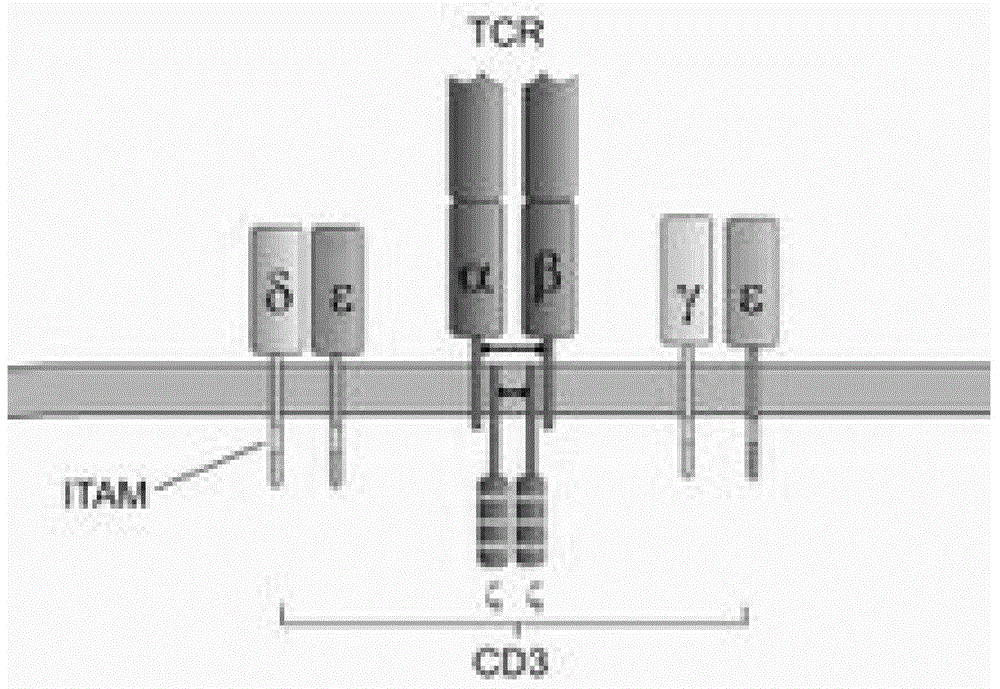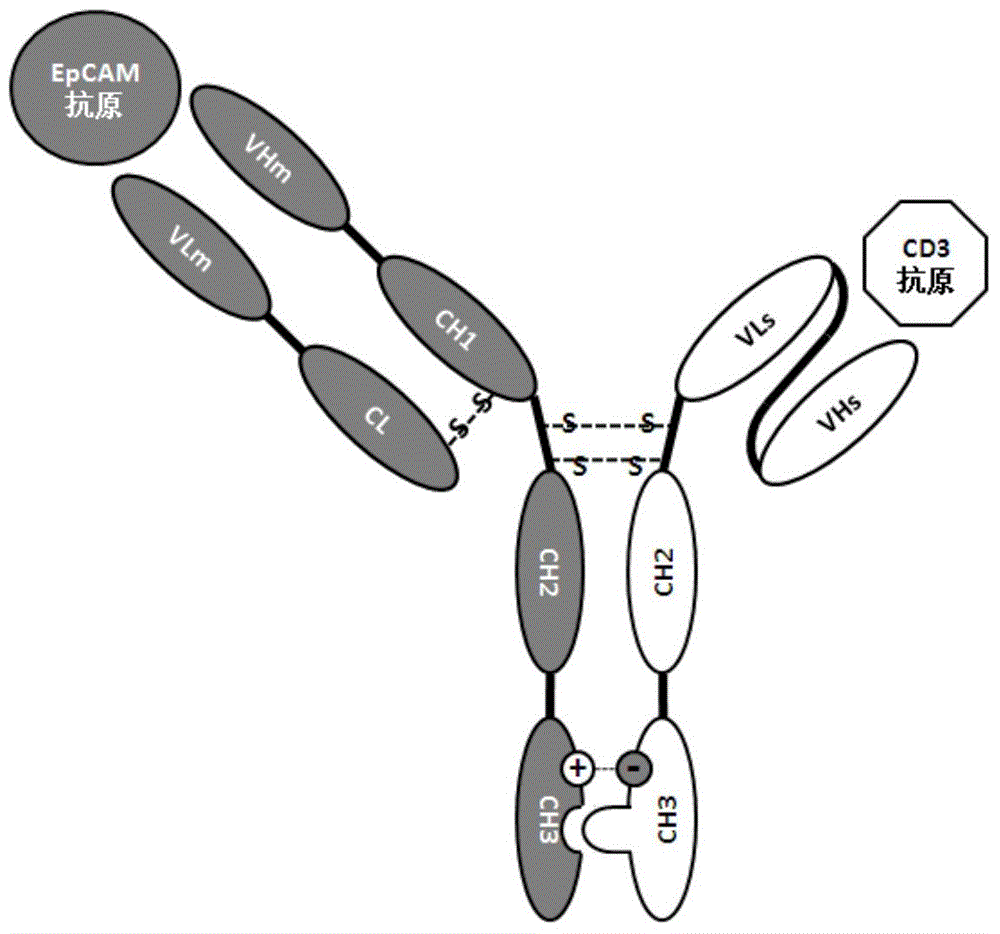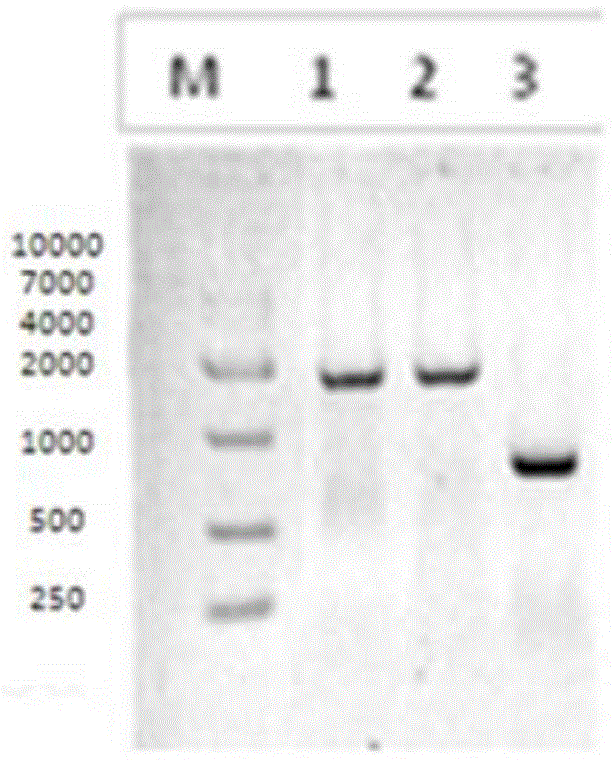Construction method and application of bispecific antibody EpCAM*CD3
A bispecific antibody, antibody technology, applied in the direction of antibodies, anti-animal/human immunoglobulin, anti-receptor/cell surface antigen/cell surface determinant immunoglobulin, etc., can solve the problem of limited efficacy in solid tumors , to achieve improved efficacy, increase the effect of immunotherapy
- Summary
- Abstract
- Description
- Claims
- Application Information
AI Technical Summary
Problems solved by technology
Method used
Image
Examples
Embodiment 1
[0072] Example 1: Construction of expression vectors for bispecific antibodies (EpCAM×CD3, M701)
[0073] 1. Bispecific antibody sequence design
[0074] The bispecific antibody targeting EpCAM and CD3 was named M701, as figure 2 , the anti-EpCAM side is in the form of IgG, including anti-EpCAM heavy chain and light chain, containing Fab and Fc domains; the anti-CD3 side is in the form of ScFv-Fc, including anti-CD3 VH, VL, and Fc domains. Among them, the IgG form undergoes KKW transformation on one side of Fc, and the side of ScFv-Fc undergoes LDY transformation on Fc. For the specific Fc transformation process, refer to PCT / CN2012 / 084982, so that they are not easy to form homodimers, but easy to form hybrid dimers, namely EpCAM×CD3 bispecific antibody. At the same time, in order to express the diabody in CHO cells and secrete it into the culture medium, the leader peptide sequence of the mouse kappa chain was selected as the secretion signal peptide. The amino acid seque...
Embodiment 2
[0099] Example 2: Expression and purification of bispecific antibodies
[0100] 1. Expression of bispecific antibodies
[0101] The endotoxin-free large-scale extraction kit (Qiagen, 12391) was used for large-scale extraction of plasmids, and the specific operation was performed according to the instructions provided by the manufacturer. CHO-S cells were cultured in CD CHO medium (Gibco, 10743-029) at 37°C in 5% CO according to the instructions provided by the manufacturer. 2 The cells were cultured in the incubator. After the cells were prepared, the plasmid pCHO1.0-anti-EpCAM-HL-KKW and pCHO1.0-hygromycin-L2K- ScFv-Fc-LDY were co-transfected together into CHO-S cells, and the co-transfection of these two plasmids was designed to express the bispecific antibody M701 against EpCAM×CD3.
[0102] On the second day after transfection, the culture temperature was lowered to 32° C., and 3.5% FeedA was added every day. After 14 days of culture, the expression supernatant was harve...
Embodiment 3
[0105] Example 3: Determination of the binding activity of bispecific antibodies to cells (FACS)
[0106] The bispecific antibody of the invention binds to the target antigen on the corresponding cell. In the present invention, HCT116 (purchased from ATCC, CCL-247) is used as EpCAM-positive cells, Jurkat (Jurkat, TIB-152) is used as CD3-positive cells, and the cell binding activity is determined by the diabody prepared in the present invention.
[0107] 1. Detection of binding activity of bispecific antibody to HCT116 cells by flow cytometry
[0108] Sufficient HCT116 cells were cultured, digested with 0.25% trypsin, and collected by centrifugation. Simultaneously dilute the bispecific antibody, the concentration starts from 10ug / ml, and 10-fold gradient dilution is obtained to obtain 12 concentration gradients for future use. Wash the collected cells twice with PBS+1%FBS, then resuspend the cells in PBS+1%FBS to 4×10 6 cells / ml, the cells were plated in a 96-well plate, 50...
PUM
 Login to View More
Login to View More Abstract
Description
Claims
Application Information
 Login to View More
Login to View More - R&D
- Intellectual Property
- Life Sciences
- Materials
- Tech Scout
- Unparalleled Data Quality
- Higher Quality Content
- 60% Fewer Hallucinations
Browse by: Latest US Patents, China's latest patents, Technical Efficacy Thesaurus, Application Domain, Technology Topic, Popular Technical Reports.
© 2025 PatSnap. All rights reserved.Legal|Privacy policy|Modern Slavery Act Transparency Statement|Sitemap|About US| Contact US: help@patsnap.com



